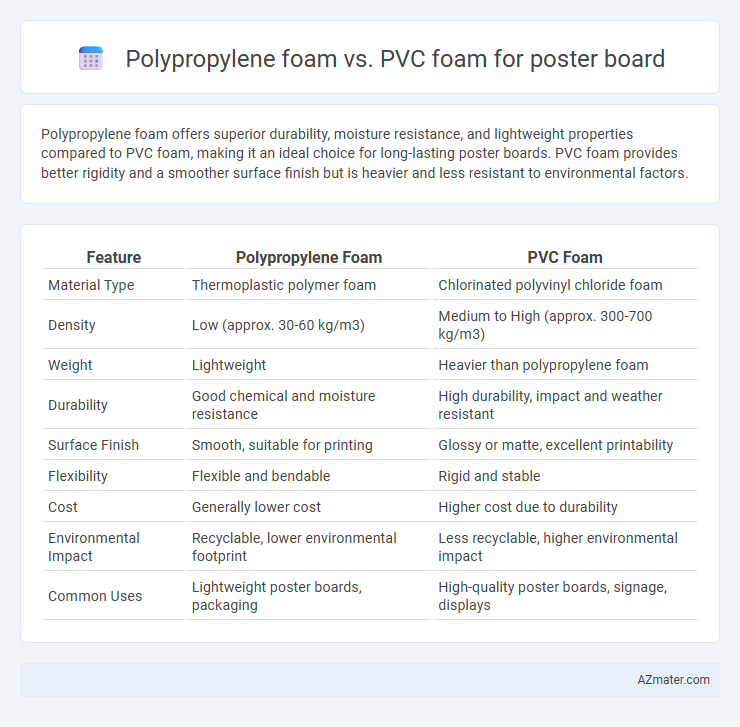Polypropylene foam offers superior durability, moisture resistance, and lightweight properties compared to PVC foam, making it an ideal choice for long-lasting poster boards. PVC foam provides better rigidity and a smoother surface finish but is heavier and less resistant to environmental factors.
Table of Comparison
| Feature | Polypropylene Foam | PVC Foam |
|---|---|---|
| Material Type | Thermoplastic polymer foam | Chlorinated polyvinyl chloride foam |
| Density | Low (approx. 30-60 kg/m3) | Medium to High (approx. 300-700 kg/m3) |
| Weight | Lightweight | Heavier than polypropylene foam |
| Durability | Good chemical and moisture resistance | High durability, impact and weather resistant |
| Surface Finish | Smooth, suitable for printing | Glossy or matte, excellent printability |
| Flexibility | Flexible and bendable | Rigid and stable |
| Cost | Generally lower cost | Higher cost due to durability |
| Environmental Impact | Recyclable, lower environmental footprint | Less recyclable, higher environmental impact |
| Common Uses | Lightweight poster boards, packaging | High-quality poster boards, signage, displays |
Introduction to Polypropylene Foam and PVC Foam for Poster Boards
Polypropylene foam offers lightweight durability, high chemical resistance, and excellent moisture resistance, making it ideal for outdoor poster boards that require longevity and structural integrity. PVC foam, known for its rigidity and smooth surface finish, provides superior print quality and ease of cutting, which benefits indoor poster displays and exhibition materials. Both materials are widely used in poster boards, but the choice depends on specific needs such as exposure to elements, weight considerations, and printing requirements.
Material Composition and Properties
Polypropylene foam, composed of a thermoplastic polymer made from propylene monomers, offers excellent chemical resistance, lightweight structure, and strong impact absorption, making it suitable for durable poster boards. PVC foam, derived from polyvinyl chloride resin, provides superior rigidity, high dimensional stability, and inherent flame retardancy, ensuring sturdy and long-lasting display surfaces. Both materials exhibit moisture resistance, but polypropylene foam typically excels in flexibility and recyclability, while PVC foam maintains better structural strength and surface finish quality.
Lightweight Benefits: Polypropylene vs PVC Foam
Polypropylene foam offers significant lightweight advantages over PVC foam, making it ideal for poster boards that require easy handling and transport. With a lower density, polypropylene foam reduces the overall weight without compromising durability or rigidity. This weight savings enhances convenience during installation and display, especially for large-format poster boards.
Durability and Impact Resistance Comparison
Polypropylene foam exhibits superior durability and impact resistance compared to PVC foam, making it ideal for long-lasting poster boards subjected to frequent handling or external stress. Its cellular structure provides enhanced flexibility and less brittleness, reducing the risk of cracking or breaking under impact. PVC foam, while offering a smooth surface finish, tends to be more rigid and prone to deformation or damage when exposed to heavy impacts over time.
Printability and Surface Finish
Polypropylene foam offers superior printability due to its smooth, non-porous surface, ensuring crisp graphics and vibrant colors on poster boards. PVC foam features a slightly textured surface that may absorb inks unevenly, potentially impacting print clarity and requiring specialized coatings for optimal results. Both materials provide durable finishes, but polypropylene foam is often favored for high-quality, detailed print applications.
Environmental Impact and Recyclability
Polypropylene foam offers a more eco-friendly alternative to PVC foam for poster boards due to its lower environmental impact and higher recyclability rates. PVC foam is derived from polyvinyl chloride, which releases harmful chemicals during production and disposal, contributing to toxic pollution and challenging recycling processes. Polypropylene foam can be more easily recycled into new products, reducing landfill waste and promoting a circular economy in display materials.
Cost Analysis and Affordability
Polypropylene foam offers a cost-effective solution for poster boards due to its lower raw material and manufacturing expenses compared to PVC foam, making it an affordable option for bulk purchases. PVC foam typically incurs higher production costs because of its density and chemical composition, resulting in a more expensive final product. For budget-conscious projects, polypropylene foam delivers adequate durability and print quality while maintaining affordability, whereas PVC foam is reserved for premium applications requiring enhanced rigidity and surface finish.
Common Applications in Poster Board Use
Polypropylene foam is widely used for poster boards in retail displays, signage, and lightweight exhibition panels due to its excellent durability, moisture resistance, and easy printability. PVC foam board offers superior rigidity and weather resistance, making it ideal for outdoor signage, architectural models, and long-term promotional displays. Both materials are favored for their smooth surface and ability to hold vibrant graphics, but polypropylene foam is preferred when flexibility and recyclability are prioritized.
User Experience and Handling
Polypropylene foam offers lightweight durability and excellent flexibility, making it easier to handle and resist deformation during transport or display. PVC foam provides a rigid, smooth surface ideal for high-quality printing and sharper image resolution, enhancing the visual presentation of posters. Users appreciate polypropylene foam for its impact resistance and ease of cutting, while PVC foam is favored for professional-grade finishes and stability in framing or mounting.
Conclusion: Choosing the Best Foam for Poster Boards
Polypropylene foam offers superior durability, lightweight properties, and excellent chemical resistance, making it ideal for long-lasting poster boards used in various environmental conditions. PVC foam provides a smooth surface with better print quality and rigidity, suited for short-term indoor displays where visual appeal is critical. Selecting the best foam depends on the specific use case: polypropylene foam for robustness and outdoor use, PVC foam for high-quality printing and indoor applications.

Infographic: Polypropylene foam vs PVC foam for Poster board
 azmater.com
azmater.com